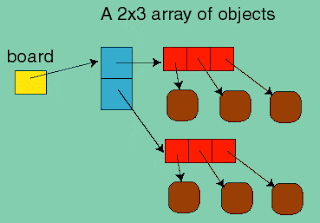
In my Java programming college class, we are learning more and more about classes. Specifically we are learning about access modifiers for instance variables and methods. One thing that is pretty clear is that if you have an instance variable in a class, and the variable name is
myVar, then you cannot have another instance variable in the same class with the same variable name.
Within the class, you can reference an instance variable with just its name. You can optionally
prepend the variable name with the keyword “this”. However in this scenario, “this” which represents the current object is already implied. So for most if not all of the time, the “this” keyword is omitted.
We are also learning about
accessors and
mutators in our programming class.
Mutators, or setters, take an argument and set the instance variable to the value of that argument. Here is where some confusion in class came up. Support we have an instance variable in our class named “email”. What should we name the formal parameter of the
setEmail method?
Most of the time, the simplest and most obvious variable name is the best one. So I thought I would name the formal argument to the
mutator setEmail to be just “email”. But here is the problem and question. Does the local variable email, which is the formal parameter to the method in the class, clash with the instance variable of the same name?
The best way to answer questions like this is to try it out. It compile fine. So it must be
ok. The only tricky part comes when you must set the instance variable to the formal parameter passed into the method. How do you do that if they are named the same? The trick is to qualify the instance variable with the “this” keyword. Then you get code that looks like this (no pun intended):
public void
setEmail(String email)
{
this.email = email;
}
Now this may not be the best practice, as there might be some ambiguity as to which variable the name email refers to. So our instructor insisted that we name the formal parameter
newEmail, or something else distinct from the instance variable name. That sounds logical. It was still cool to find out you could have two variables of the same name within the class.
 I had a little free time at work. So I decided to quickly code up a small application to do some work on Windows. I wanted to showcase this application on the Black of Hat blog.
I had a little free time at work. So I decided to quickly code up a small application to do some work on Windows. I wanted to showcase this application on the Black of Hat blog.







 I am on a 7 Day Quest to write a game in Java. That's a tall order since I am only half way through a college Java class. But I am learning a lot.
I am on a 7 Day Quest to write a game in Java. That's a tall order since I am only half way through a college Java class. But I am learning a lot. I have previously written about my recent exploits in the game development field. To make sure I gain Java programming skills during this
I have previously written about my recent exploits in the game development field. To make sure I gain Java programming skills during this 
 I am halfway through my college class on Java. There are a number of topics we have not covered yet. Normally that is fine, as we will eventually get to them. However I just entered a programming contest to write a Java game in 7 days. My game will be called
I am halfway through my college class on Java. There are a number of topics we have not covered yet. Normally that is fine, as we will eventually get to them. However I just entered a programming contest to write a Java game in 7 days. My game will be called  I read the magazine Software Test and Performance. This is because formal testing plays a large role in the project I work on. The development team does unit testing. An internal team does integration, functional, and regression testing. A customer team conducts software acceptance testing. I need to keep up with the world of testing.
I read the magazine Software Test and Performance. This is because formal testing plays a large role in the project I work on. The development team does unit testing. An internal team does integration, functional, and regression testing. A customer team conducts software acceptance testing. I need to keep up with the world of testing. Sun
Sun  When I started learning Java, I downloaded the
When I started learning Java, I downloaded the  I keep my eyes peeled for any software articles about Java. Recently I read a front page article about Java Enterprise Edition 6 being very bloated. A solution is to wait for the Java Standard Edition 7 to come out. However I get the feeling that Java SE 7 is somehow delayed for a long time.
I keep my eyes peeled for any software articles about Java. Recently I read a front page article about Java Enterprise Edition 6 being very bloated. A solution is to wait for the Java Standard Edition 7 to come out. However I get the feeling that Java SE 7 is somehow delayed for a long time.



